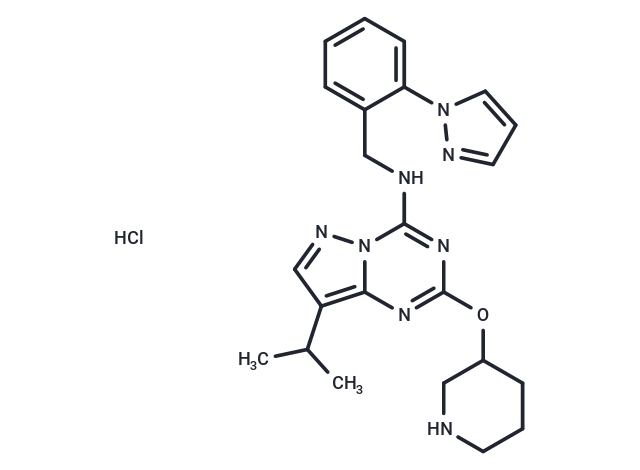Shopping Cart
- Remove All
 Your shopping cart is currently empty
Your shopping cart is currently empty

LDC4297 is a potent and selective CDK7 inhibitor with an IC50 of 0.13 nM.

| Pack Size | Price | Availability | Quantity |
|---|---|---|---|
| 1 mg | $54 | In Stock | |
| 2 mg | $77 | In Stock | |
| 5 mg | $98 | In Stock | |
| 10 mg | $175 | In Stock | |
| 25 mg | $357 | In Stock | |
| 50 mg | $529 | In Stock | |
| 100 mg | $767 | In Stock | |
| 1 mL x 10 mM (in DMSO) | $98 | In Stock |
| Description | LDC4297 is a potent and selective CDK7 inhibitor with an IC50 of 0.13 nM. |
| Targets&IC50 | CDK7:0.13 nM |
| In vitro | The affinity of LDC4297 for CDK7 proves to be extremely high. Kinase assays performed for CDK1, CDK2, CDK4, CDK6, CDK7, and CDK9 confirms the selective inhibitory activity of LDC4297 for CDK7 in the nano-picomolar range (IC50, 0.13±0.06 nM for CDK7 versus IC50s between 10 nM and 10,000 nM for all other analyzed CDKs). LDC4297 exerts anticytomegaloviral activity. Human cytomegalovirus (HCMV) replication is inhibited by LDC4297 in a concentration-dependent manner with an EC50 value of 24.5±1.3 nM. Inhibition is statistically significant and morphological signs of cytotoxicity only occurrs at concentrations of 3.3 μM or higher. Anti-HCMV activity of LDC4297 is exerted through a multifaceted mode of action that involves an interference with virus-induced Rb phosphorylation. Virus replication is broadly blocked by LDC4297, whereby the antiviral efficacies varied between the viruses used, i.e., strong efficacy for HSV-1 and VZV (EC50s = 0.02 and 0.06 μM, respectively) and intermediate to low efficacy for HSV-2 and EBV (EC50s = 0.27 and 1.21 μM, respectively |
| In vivo | An analysis of the PK parameters in CD1 mice reveals positive characteristics after oral administration, as demonstrated for a single-dose treatment (100 mg/kg of LDC4297). The half-life (t1/2z) is determined to be 1.6 h, and a time (Tmax) to a mean peak plasma concentration of 1,297.6 ng/mL is reached 0.5 h after administration, with a continued presence of LDC4297 plasma levels for at least 8 h and a bioavailability of 97.7% |
| Cell Research | A trypan blue exclusion assay is performed with cultured cells seeded in 24-well plates and incubated with increasing concentrations of antiviral compound LDC4297 (range, 0.1 to 50 μM) for the durations indicated. Cell staining is achieved with 0.1% trypan blue for 10 min at room temperature before the percentage of viable cells is determined by microscopic counting |
| Molecular Weight | 469.02 |
| Formula | C23H29ClN8O |
| Smiles | Cl.CC(C)c1cnn2c(NCc3ccccc3-n3cccn3)nc(OC3CCCNC3)nc12 |
| Relative Density. | no data available |
| Storage | Powder: -20°C for 3 years | In solvent: -80°C for 1 year | Shipping with blue ice. | |||||||||||||||||||||||||||||||||||
| Solubility Information | DMSO: 60 mg/mL (127.93 mM), Sonication is recommended. | |||||||||||||||||||||||||||||||||||
Solution Preparation Table | ||||||||||||||||||||||||||||||||||||
DMSO
| ||||||||||||||||||||||||||||||||||||

Copyright © 2015-2025 TargetMol Chemicals Inc. All Rights Reserved.